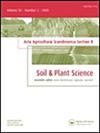Monitoring and control of the carrot fly (Psila rosae fabr.) in northern Norway
IF 1.8
4区 农林科学
Q2 AGRONOMY
Acta Agriculturae Scandinavica Section B-Soil and Plant Science
Pub Date : 1999-01-01
DOI:10.1080/09064719909362512
引用次数: 2
Abstract
A 4‐year study (1991–94) focused on (1) the use of yellow sticky traps to monitor carrot fly activity, (2) insecticide control trials, and (3) analyses for insecticide residues in carrots in northern Norway. There was only one generation of flies each year. In most fields, first flies appeared in the second part of June, with a peak fly activity occurring in the first part of July. The maximum difference in peak activity from one year to the next was 3 weeks. In five trials in which the fly infestation was high, 10–100% of the roots were damaged and marketable yield was reduced by 30–100%. Satisfactory control was achieved by drenching the crop with the organophosphorous insecticides diazinon or fenthion, timed according to catch on traps. Seed coating (isofenphos) had an unreliable, often lacking, effect. Residue levels of the fenthion in the carrots at harvest were unacceptable, even when this insecticide was applied at the recommended rates.挪威北部胡萝卜蝇(Psila rosae fabr.)监测与防治
一项为期4年的研究(1991 - 1994)集中于(1)使用黄色粘捕器监测胡萝卜蝇活动,(2)杀虫剂控制试验,(3)分析挪威北部胡萝卜中的杀虫剂残留。每年只有一代苍蝇。大多数田区蝇类首飞出现在6月下旬,蝇类活动高峰出现在7月上旬。一年与下一年的高峰活动最大差异为3周。在蝇害严重的5个试验中,10-100%的根被破坏,可售产量减少30-100%。用有机磷杀虫剂二嗪农或倍硫磷按捕集器定时对作物进行浇水,取得了满意的防治效果。种子包衣(异苯磷)不可靠,往往缺乏效果。收获时胡萝卜中倍硫磷的残留水平是不可接受的,即使按建议用量施用这种杀虫剂。
本文章由计算机程序翻译,如有差异,请以英文原文为准。
求助全文
约1分钟内获得全文
求助全文
来源期刊
CiteScore
4.40
自引率
0.00%
发文量
56
审稿时长
2.3 months
期刊介绍:
Acta Agriculturæ Scandinavica Section B publishes original research in applied soil and plant science with special attention given to to crop production in agri- and horticultural systems. We welcome manuscripts dealing with:
Climate smart and sustainable crop production systems
Water and nutrient efficiency
Soil conservation and productivity
Precise agriculture systems
Applications of bio- and nanotechnology
Digitalisation and robotics
Soil-plant interactions
Acta Agriculturæ Scandinavica, Section B – Soil & Plant Science forms part of a series of titles published on behalf of the Nordic Association of Agricultural Science (NJF). The series also includes Section A - Animal Science .

 求助内容:
求助内容: 应助结果提醒方式:
应助结果提醒方式:


